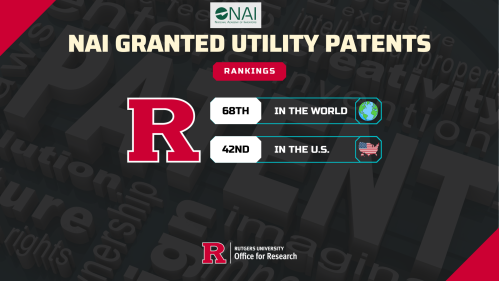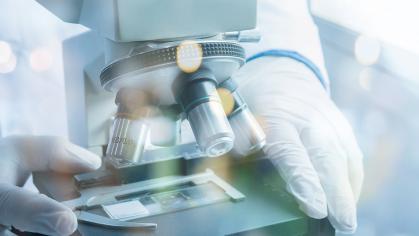Rutgers Moves Up Four Spots in NAI Top 100 U.S. Universities Granted Utility Patents Rankings

Rutgers, The State University of New Jersey, improved its standing in the National Academy of Inventors (NAI) Top 100 U.S. Universities Granted Utility Patents, moving up four spots from the previous year to come in 42nd in 2024. This comes on the heels of the NAI’s announcement of its worldwide rankings, in which Rutgers placed 68th.
Rutgers has appeared in each NAI Top 100 Worldwide Universities list since its inception in 2013; the Top 100 U.S. Universities list was introduced in 2023. Collectively, the universities on the 2024 Top 100 U.S. list hold over 6,700 patents.
“To be ranked in the top 100 in both the United States and the world in granted utility patents is a remarkable achievement, and a testament to the strength of the research conducted at Rutgers as well as the work done by the Office for Research’s Technology Transfer Team,” said Michael E. Zwick, PhD, senior vice president for Research. “We are proud of our rankings in the NAI lists, and even prouder of what the rankings represent: Rutgers’ role in solving societal changes.”
“The patent process is a collaborative venture between Rutgers researchers and the Technology Transfer team, and the NAI worldwide and U.S. rankings are well-deserved recognitions for the hard work and dedication of both groups,” said Technology Transfer executive director Deborah Perez Fernandez, PhD, MBA.
Rutgers' technology transfer process kicks off when a faculty member reports a new innovation through the Rutgers Innovator Portal. This initiates the journey of safeguarding, promoting, and licensing technologies with high commercial potential. The Rutgers Office for Research Technology Transfer unit evaluates various aspects of the submission, such as the technology's unique features, development stage, patentability, and market applications and potential, to decide if a US provisional patent application should be submitted to the US Patent and Trademark Office (USPTO).
These evaluations continue throughout the patent application process, with the tech transfer team collaborating closely with the inventor(s) and external legal advisors to ensure proper patent protection. Once a patent application is filed, marketing and outreach efforts commence. The Rutgers Technology Transfer team aims to license the technology to a large corporation, small business, or start-up that has the interest and capability to further develop and commercialize the innovation. For more details about the process, click here.
The Top 100 Worldwide Universities ranking highlights the critical role patents play in translating university research and innovation and the important role academic institutions play in the innovation ecosystem at large. NAI Member Institutions comprise 58% of the ranking and hold over 5,600 patents. By obtaining U.S. patents, these institutions can translate their technologies into the competitive global market and make tangible impacts on consumers' daily lives.
“Global competition in science and technology is intense. To continue to keep our nation secure, we must invest in accelerating breakthrough technologies, transitioning these technologies to the market, and preparing Americans for better-quality, higher-wage jobs,” said U.S. National Science Foundation Director Sethuraman Panchanathan. “NSF supports the translation of technologies from academic research to the marketplace through programs like the NSF Innovation Corps and the Directorate for Technology, Innovation, and Partnerships, which focuses on accelerating use-inspired research and its societal impact. The impacts of these investments are being felt in key technology areas nationwide.”
The Top 100 U.S. Universities List is one of three annual rankings which are published by the National Academy of Inventors. These rankings are based on calendar year data provided by the United States Patent and Trademark Office and aim to provide a comprehensive view of intellectual property protection in the innovation ecosystem. The Top 100 Worldwide Universities ranking was published in March and Top 60 Non-Profit Research Institutions and Government Agencies rankings will be released this spring leading up to NAI’s 14th Annual Conference held in Atlanta, Georgia. See the Top 100 U.S. Universities list here.
RUTGERS PATENT RECIPIENTS 2024
|
US Utility Patent Number |
Inventors |
Title |
|
12,180,269 |
Wadih Arap, Andrew Bradbury, Sara D'Angelo, Fortunato Ferrara, Renata Pasqualini, Fernanda Staquicini |
GRP78-binding antibodies and uses thereof in detecting or neutralizing GRP78 |
|
12,178,205 |
Joseph Benevenia, Sheldon Lin, Michael Vives |
Systems and methods for storing and preserving implantable devices |
|
12,172,974 |
Garry Robert Smith, Allen B. Reitz, Mark McDonnell, Suzie Chen, Matthew D. Vera, Benjamin E Blass, Jeffrey Claude Pelletier, Venkata N. Velvadapu, Jay Edward Wrobel |
Prodrugs of riluzole and their method of use |
|
12,168,685 |
Wadih Arap, Andrew Bradbury, Sara D'Angelo, Fortunato Ferrara, Renata Pasqualini, Fernanda Staquicini |
Phage-displayed accessible recombinant targeted antibodies and methods of making same |
|
12,163,113 |
Ileana Marrero-Berrios, Rene Schloss, Anil Shrirao, Martin Yarmush |
Multilayer stackable tissue culture platform for 3D co-culture |
|
12,162,216 |
Lin Lei, Jonathan Singer |
Thickness-limited electrospray deposition |
|
12,156,889 |
Guangwen Ren, Yufang Shi, Liying Zhang |
Methods of administering mesenchymal stem cells activated by cytokines for enhancing immunosuppression |
|
12,146,197 |
Salvatore Marras, Nikhat Parveen |
Multiplex diagnostic assays for Lyme disease and other tick-borne diseases |
|
12,144,553 |
Partho Sengupta |
Dynamic flow phantom for in vitro cardiac intervention pre-procedure planning and testing using patent specific 3D printed anatomical models |
|
12,141,240 |
Roman Brukh |
Method of calibration using master calibration function |
|
12,139,768 |
David Alland, Soumitesh Chakravorty |
Polymerase chain reaction primers and probes for Mycobacterium tuberculosis |
|
12,122,742 |
Dhulfiqar Abed, Longqin Hu |
Small molecule direct inhibitors of KEAP1-NRF2 protein-protein interaction |
|
12,115,519 |
Supriya Atta, Fuat Celik, Laura Fabris, Ashley Pennington |
Near infrared photocatalyst based on TiO.SUB.2.-coated gold nanoparticles |
|
12,115,213 |
Amariliz Rivera, Chaoyang Xue |
Methods of treating fungal infections |
|
12,109,237 |
Saiaditya Badeti, Dongfang Liu, Minh Ma |
S309 chimeric antigen receptors and methods of use |
|
12,103,966 |
Wadih Arap, Andrew Bradbury, Sara D'Angelo, Fortunato Ferrara, Renata Pasqualini, Fernanda Staquicini |
GRP78-binding antibodies and uses thereof in detecting or neutralizing GRP78 |
|
12,098,026 |
Eva Andrei, Angela Coe, Guohong Li |
Electrochemical cell having thin metal foil packaging and a method for making same |
|
12,097,500 |
Mark George Allen, Mehdi Javanmard, Wen Shen, Naixin Song, Pengfei Xie |
Apparatus and methods for monitoring of biomarkers in blood |
|
12,087,904 |
Glenn Amatucci, Anthony Ferrer, Irene Plitz, Linda Wu Sung |
Electrochemical cell having thin metal foil packaging and a method for making same |
|
12,082,914 |
Gillian Cannon, Andrew Gow |
Evaluation system for cardiovascular health assessment and individualized health and fitness interventions |
|
12,065,700 |
Christopher Mason, Jeffrey Rosenfeld, Delia Tomoiaga |
Single sperm gene expression and mutation analysis for prediction of diseases |
|
12,065,666 |
Juan-Carlos Collantes, Shengkan (Victor) Jin |
Targeted gene editing platform independent of DNA double strand break and uses thereof |
|
12,061,201 |
Edgar Ferrer-Gonzalez, Edmond LaVoie, Daniel Pilch |
Fluorescent probes for the visualization of FtsZ in gram-positive and gram-negative bacterial pathogens |
|
12,060,415 |
Wadih Arap, Andrew Bradbury, Sara D'Angelo, Fortunato Ferrara, Renata Pasqualini, Fernanda Staquicini |
GRP78-binding antibodies and uses thereof and selection of phage-displayed accessible recombinant targeted antibodies |
|
12,060,330 |
David Alland, Divya Awasthi, Glenn Capodagli, Sean Ekins, Joel Freundlich, Pradeep Kumar, Matthew Neiditch |
Therapeutic indazoles |
|
12,049,492 |
Saiaditya Badeti, Dongfang Liu, Minh Ma |
CR3022 chimeric antigen receptors and methods of use |
|
12,046,129 |
Xiaoli Bai, Hao Peng |
Computer-based systems configured for space object orbital trajectory predictions and methods thereof |
|
12,041,178 |
Chen Cong, Naftaly Minsky, David Zimmerman |
Scalable, secure, and broad-spectrum mechanism for enforcement of protocols over multi-agent systems |
|
12,037,529 |
Ki-Bum Lee, Nicholas Pasquale, Hudifah Rabie, Yixiao Zhang |
Luminescent layered composition and a method for using the composition |
|
12,030,983 |
Durgadas Bolikal Bolikal, Joachim Kohn |
Polymeric biomaterials derived from phenolic monomers and their medical uses |
|
12,027,660 |
Glenn Amatucci, Anthony Ferrer, Irene Plitz, Linda Wu Sung |
Electrochemical cell having thin metal foil packaging and a method for making same |
|
12,018,099 |
Xiao Hu, Stacy Love, David Salas-De La Cruz, David Verrill |
Methods of modifying cellulose crystallinity |
|
11,995,986 |
Marco Gruteser, Suhas Mathur |
Vehicular information systems and methods |
|
11,993,592 |
Thomas Dugan, Alan Goldman |
Phebox ligands and methods of making same |
|
11,993,571 |
Edmond LaVoie, Ajit Parhi, Yangsheng Sun, Yi Yuan, Yongzheng Zhang |
Indole derivatives as efflux pump inhibitors |
|
11,992,362 |
Max Balter, Alvin Chen, Joshua Leipheimer, Martin Yarmush |
Ultrasound-guided alignment and insertion of percutaneous cannulating instruments |
|
11,987,777 |
Hao Lin, Jerry Shan, David Shreiber, Jeffrey Zahn, Mingde Zheng |
High throughput, feedback-controlled electroporation microdevice for efficient molecular delivery into single cells |
|
11,984,030 |
Marco Gruteser, Suhas Mathur |
Vehicular information systems and methods |
|
11,974,659 |
Vivek Kumar, Maxine Strickland |
Toothbrush suction apparatus and method |
|
11,964,987 |
Achyutharao Sidduri |
Isoidide derivatives and methods of making and using same |
|
11,964,019 |
Ruying Lu, Raphael Mannino |
Cochleates made with soy phosphatidylserine |
|
11,951,476 |
Umer Hassan, Corey Norton |
Electronic-sensing and magnetic-modulation (ESMM) biosensor for phagocytosis quantification in pathogenic infections and methods of use thereof |
|
11,943,038 |
Anastasios Dimas, Dionysios Kalogerias, Athina Petropulu |
Relay beamforming with predictive relay selection for millimeter wave communications |
|
11,939,402 |
Robert Tancer, Gregory Wiedman, Chaoyang Xue |
Antifungal peptides, compounds including the same, and methods of use thereof |
|
11,938,463 |
Baiyan Li, Jing Li |
Metal-organic framework based molecular traps for capture of radioactive organic iodides from nuclear waste |
|
11,938,114 |
Edmond LaVoie, Ajit Parhi, Yongzheng Zhang |
Bacterial efflux pump inhibitors |
|
11,928,336 |
David Domingo, Sudarsun Kannan, Rekha Pitchumani, Yujie Ren |
Systems and methods for heterogeneous storage systems |
|
11,924,227 |
Honggang Wang, Saman Aliari Zonouz |
Hybrid unsupervised machine learning framework for industrial control system intrusion detection |
|
11,918,951 |
Jing Li, Hao Wang |
MOF compositions for selective separation of hydrocarbons |
|
11,911,054 |
Amit Singla |
Neuroaspiration catheter for thrombectomy |
|
11,896,713 |
Olga Garbuzenko, Tamara Minko |
Strategies to enhance lung cancer treatment |
|
11,884,985 |
David Denning, Steven Park, David Perlin |
Assays for fungal infection |
|
11,872,250 |
Guangwen Ren, Yufang Shi, Liying Zhang |
Methods for inducing an immune response by administering activated mesenchymal stem cells |
|
11,857,425 |
Michael Dunn, Charles Gatt, Jay Patel |
System and method for making personalized fibrocartilage implants |
|
11,857,307 |
Gal Hayam, Michael Timofeyev, Tal Haim Bar-on, Amardeep Saluja |
Finding the origin of an arrythmia |
###
About Rutgers, The State University of New Jersey
Rutgers, The State University of New Jersey, is a leading national research university and the state of New Jersey’s preeminent, comprehensive public institution of higher education.
Established in 1766, the university is the eighth-oldest higher education institution in the United States. More than 67,000 students and 27,400 faculty and staff learn, work, and serve the public at Rutgers-New Brunswick, Rutgers-Newark, Rutgers-Camden, and Rutgers Health.
###
About the Top 100 Worldwide Universities Granted Utility Patents in 2024
The information provided in this list is based on data obtained from the U.S. Patent and Trademark Office. For this report, a university is defined as an institution that has undergraduate degrees. Patents include only utility patents granted during the 2024 calendar year. All assignees are credited for patents when listed. The number of patents granted does not necessarily indicate the value of a university’s technology, the effectiveness of its research, or whether its patents will be successfully licensed and/or brought to market. This is a dynamic list of worldwide institution patents. Some universities may record patents under different, yet similar names or combine their patents under one foundation or trustee name. If you have questions please contact: info@academyofinventors.org
###
About the National Academy of Inventors
The National Academy of Inventors is a member organization comprising U.S. and international universities, and governmental and non-profit research institutes, with over 4,600 individual inventor members and Fellows spanning more than 260 institutions. It was founded in 2010 to recognize and encourage inventors with patents issued from the U.S. Patent and Trademark Office, enhance the visibility of academic technology and innovation, encourage the disclosure of intellectual property, educate and mentor innovative students, and translate the inventions of its members to benefit society. The Academy and the USPTO have enjoyed a collaborative partnership since the founding of NAI. Most recently this has been reflected in their joint mission to expand access to the innovation ecosystem through a focus on actively valuing and leveraging every individual’s unique perspectives, talents, and contributions. www.academyofinventors.org
###



